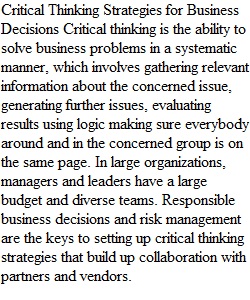


Q Learning Objectives • Examine the process involved with problem formulation. • Apply critical thinking to problem identification. • Evaluate ethical implications of a decision. Prompt: Choose an editorial article (An editorial is an article that presents the writer's opinion on an issue supported with facts) from the New York Times, the Wall Street Journal or browse the library and choose an editorial that addresses a business issue that interests you. Instructions: Write an essay describing the following: • Citation of the article and a brief summary of its contents • What are the premise(s) in the article? • What evidence is presented? Is it credible? • Can you independently verify the evidence presented? • How are counterarguments addressed? • Does the writer represent a particular interest? • How is language used to develop the argument? • Do you detect any errors in knowledge, evidence, or thinking? • Does the writer use any types of appeals or commit any fallacies? • Overall, how compelling is this article? Be certain to carefully research your analysis using at least 4 credible sources properly incorporated. Your submission should be 4-6 pages in length minimum and should be a thorough representation of your ability to critically think through the steps above. Use the template provided to ensure you are following APA format. This assignment is worth 14% of your final grade. Grading Rubric: A rubric is provided for your convenience that details how this assignment will be graded. Please review it carefully prior to submitting your assignment. If the grading rubric does not auto-populate here, please see it by visiting the Assignment details under Course Tools.
View Related Questions